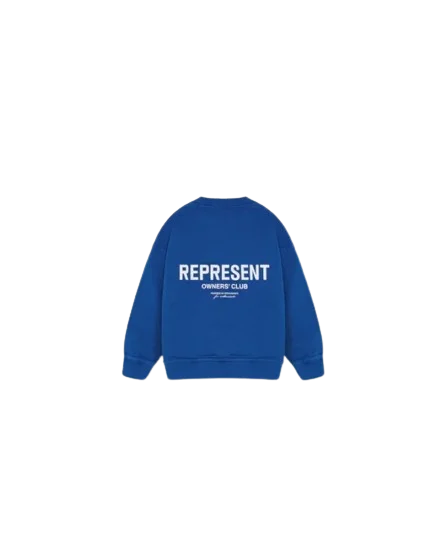The sweatshirt, once a humble piece of athletic wear, has undergone a remarkable transformation over the years to become a beloved staple in modern wardrobes worldwide. Its journey from the gym to the runway speaks volumes about its versatility Represent comfort, and unassuming charm. Today, the sweatshirt is more than just a casual garment; it has evolved into a symbol of effortless style Represent Sweatshirt offering a perfect blend of comfort and fashion-forward sensibility. In this exploration of the sweatshirt’s enduring appeal, we delve into its origins, its role in contemporary fashion, and the ways it continues to captivate people of all ages.
Origins and Evolution
The sweatshirt as we know it originated in the early 20th century. It was first designed in the 1920s by Benjamin Russell Jr., a football player looking for a comfortable Represent Clothing breathable alternative to the itchy wool jerseys worn by athletes at the time. Russell’s innovation led to the creation of a soft cotton pullover that became an instant hit with sports teams, particularly for its practicality in keeping athletes warm during outdoor activities. Its initial purpose was entirely functional: warmth, comfort, and breathability.
However, it didn’t take long for the sweatshirt to catch on beyond the realm of sports. By the mid-20th century, it was a common sight on college campuses in the United States, where it gained iconic status among students for its relaxed and comfortable fit. Soon RepresentHoodie the sweatshirt became synonymous with youth culture, rebellion, and casual, off-duty style. The rise of streetwear culture in the 1980s and 1990s further cemented the sweatshirt’s place in everyday fashion, making it a wardrobe essential that transcended socioeconomic boundaries.
Versatility and Style
What makes the sweatshirt such a compelling garment is its incredible versatility. Whether styled for a laid-back weekend look or incorporated into high-fashion ensembles, the sweatshirt adapts effortlessly to any occasion. Its simplicity is perhaps its greatest strength Represent T Shirt offering a blank canvas for endless creative expression. Designers have embraced the sweatshirt in various forms, playing with cuts, fabrics, and embellishments to elevate it from a casual staple to a fashion statement.
In recent years, luxury brands have even redefined the sweatshirt as a symbol of high fashion, with brands like Balenciaga, Gucci, and Off-White incorporating it into their collections. Oversized fits, bold logos, and graphic prints have turned the once plain sweatshirt into a coveted item. The rise of athleisure, a trend that blurs the lines between sportswear and casual wear Represent sweatpant has also played a significant role in boosting the sweatshirt’s popularity, as it perfectly encapsulates the balance between comfort and style.
From oversized, cozy designs to cropped, fitted versions, the sweatshirt can be worn in countless ways. Layer it over a collared shirt for a preppy, polished look Represent Shorts or pair it with sleek trousers and heels for an effortlessly chic outfit. Its versatility extends to all seasons, with lightweight options for warmer weather and thicker, fleece-lined versions perfect for the colder months.
A Cultural Symbol
More than just a piece of clothing, the sweatshirt has become a cultural icon. Throughout its evolution, it has represented various movements and subcultures Represent HAT In the 1980s and 1990s, for example, hip-hop artists embraced the oversized sweatshirt as part of their signature streetwear style, propelling it into the mainstream. Similarly, skaters and punk rockers adopted the sweatshirt as part of their rebellious aesthetic, often customizing it with patches, pins, and artwork to make a personal statement.
The sweatshirt’s association with activism has also grown over the years. In recent times, it has been used as a canvas for expressing political and social messages. Slogans, artwork, and symbols printed on sweatshirts allow individuals to convey their beliefs and align themselves with causes, turning the garment into a powerful medium for communication and solidarity.
The Rise of Sustainable Sweatshirts
As fashion becomes more eco-conscious, the sweatshirt has not been left behind. Many brands now offer sustainably made sweatshirts using organic cotton, recycled materials, and ethical production practices. This shift reflects a growing awareness of the environmental impact of fashion and the demand for more responsible choices. Consumers are increasingly seeking out clothing that not only looks good but also aligns with their values, and the sweatshirt fits seamlessly into this new era of mindful fashion.
Sustainable sweatshirts often come in minimalist designs that focus on longevity and durability rather than fast trends. They are intended to be wardrobe staples that can be worn season after season, reducing the need for constant replacement and contributing to a more sustainable approach to fashion consumption.
Conclusion
The sweatshirt’s journey from functional sportswear to a fashion staple is a testament to its enduring appeal. Its ability to adapt to changing trends while maintaining its core qualities—comfort, versatility, and simplicity—has ensured its place in fashion history. Whether worn casually for a day of relaxation or styled for a more polished look, the sweatshirt is a timeless piece that resonates with people from all walks of life. As the fashion industry continues to evolve, one thing is clear: the sweatshirt is here to stay, embodying the perfect balance between comfort and style, and proving that sometimes, the most understated garments are the ones that make the biggest impact.
